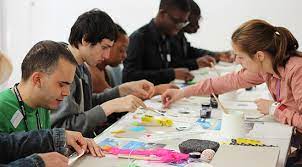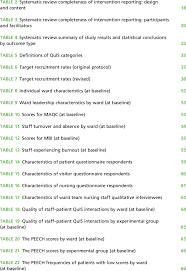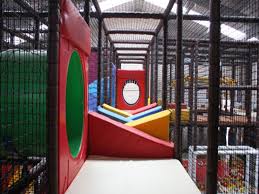
Igniting Imagination: Empowering Youth Through Creative Workshops
Youth Creative Workshops: Unlocking the Power of Imagination
In today’s fast-paced world, nurturing creativity in young minds is more important than ever. As technology continues to shape our lives, it’s crucial to provide opportunities for young people to explore their imagination and develop their creative skills. This is where youth creative workshops come into play, offering a platform for self-expression, innovation, and personal growth.
Creative workshops provide a safe and supportive environment for young individuals to explore various art forms and unleash their inner artist. From painting and drawing to writing, music, dance, and beyond, these workshops offer a diverse range of activities that cater to different interests and talents.
One of the key benefits of youth creative workshops is that they encourage critical thinking and problem-solving skills. By engaging in artistic pursuits, young participants learn how to approach challenges from different angles, think outside the box, and find unique solutions. These skills are not only valuable in the arts but also in other areas of life such as academics, career choices, and personal relationships.
Moreover, creative workshops foster self-confidence and self-expression. Through artistic exploration, young individuals discover their unique voice and learn to communicate their thoughts and emotions effectively. They gain the confidence to express themselves authentically without fear of judgment or criticism. This newfound self-assurance spills over into other aspects of their lives, empowering them to take risks and embrace new opportunities.
Collaboration is another essential aspect of youth creative workshops. Participants often work together on projects or engage in group activities that require teamwork and cooperation. This collaborative environment allows young individuals to develop essential social skills such as communication, empathy, compromise, and respect for diverse perspectives. These skills are invaluable in an increasingly interconnected world where collaboration across cultures and backgrounds is becoming the norm.
Creative workshops also provide an avenue for personal growth by encouraging experimentation and embracing failure as a stepping stone towards success. In these workshops, there are no right or wrong answers, and mistakes are seen as opportunities for growth and learning. Young participants learn to embrace their mistakes, adapt their approach, and persevere in the face of challenges. This resilience and adaptability are essential life skills that will serve them well in any future endeavor.
Furthermore, youth creative workshops offer an escape from the pressures of everyday life. In a world filled with academic demands, extracurricular commitments, and digital distractions, these workshops provide a space where young individuals can disconnect from their screens and immerse themselves in the joy of creation. It allows them to explore their passions, discover new interests, and find solace in the creative process.
In conclusion, youth creative workshops play a vital role in cultivating imagination, fostering personal growth, and developing essential life skills. By providing a platform for self-expression, collaboration, and experimentation, these workshops empower young individuals to embrace their creativity and unlock their full potential. Whether it’s painting a masterpiece or writing a captivating story, the possibilities are endless when imagination is set free through youth creative workshops.
5 Essential Tips for Youth Creative Workshops: Maximizing Engagement and Success
- Do your research – make sure you find the right workshop for the age group and interests of your participants.
- Set clear goals and expectations for the workshop – this will help ensure everyone gets the most out of it.
- Plan ahead – give yourself plenty of time to plan activities, source materials, and organise any necessary logistics such as transport or food.
- Make sure there is a good balance between structure and freedom – give participants enough guidance to get started but also allow them to explore their own ideas freely.
- Follow up afterwards – ask for feedback from participants and use it to improve future workshops or develop new ones!
Do your research – make sure you find the right workshop for the age group and interests of your participants.
Do Your Research: Finding the Perfect Youth Creative Workshop
When it comes to youth creative workshops, one size does not fit all. Each child has unique interests and abilities, and it’s essential to find a workshop that aligns with their age group and passions. So, before diving into the world of creative workshops, take some time to do your research and ensure you find the perfect fit for your participants.
First and foremost, consider the age group of the young individuals you are planning for. Different workshops cater to different age ranges, ensuring that activities are both engaging and developmentally appropriate. For younger children, workshops may focus on basic artistic techniques or sensory exploration, while older participants might delve into advanced skills or specific art forms.
Next, think about the interests of your participants. Are they drawn to painting? Writing? Music? Dance? By understanding their passions, you can narrow down your search and find workshops that align with their creative inclinations. This way, they will be more enthusiastic and motivated to participate in activities that genuinely interest them.
Take advantage of online resources and platforms dedicated to youth creative workshops. Browse through websites or social media pages that showcase various workshop offerings. Look for testimonials or reviews from parents or previous participants to get an idea of the workshop’s quality and impact on young individuals.
Don’t hesitate to reach out directly to workshop organizers or instructors with any questions you may have. They can provide valuable information about the workshop’s structure, curriculum, materials required, and any prerequisites needed for participation. This will help you gauge whether it suits your participants’ needs.
Consider attending open houses or trial sessions if available. These opportunities allow you to experience firsthand what the workshop entails and assess its suitability for your participants. Observing how instructors interact with children and witnessing their teaching style can give you a better understanding of what to expect.
Lastly, involve your participants in the decision-making process whenever possible. Discuss their interests with them and ask for their input. By including them in the selection of a workshop, they will feel a sense of ownership and excitement about the upcoming experience.
Remember, doing your research is key to finding the right youth creative workshop. By considering the age group and interests of your participants, exploring online resources, reaching out to organizers, attending open houses, and involving your participants in the decision-making process, you can ensure that you find a workshop that will ignite their creativity and provide an enriching experience for all involved.
Set clear goals and expectations for the workshop – this will help ensure everyone gets the most out of it.
Setting Clear Goals and Expectations: Maximizing the Benefits of Youth Creative Workshops
When it comes to youth creative workshops, setting clear goals and expectations is key to creating a positive and enriching experience for all participants. By establishing a framework from the start, workshop organizers can ensure that everyone involved gets the most out of their time together.
Firstly, setting clear goals helps to provide direction and purpose. Whether it’s learning a specific artistic technique, developing a particular skill, or exploring a certain theme, having defined objectives allows participants to focus their efforts and work towards tangible outcomes. This clarity not only enhances the learning process but also gives young individuals a sense of accomplishment as they strive towards their goals.
Moreover, clearly communicating expectations creates a supportive and inclusive environment. When participants know what is expected of them in terms of behavior, collaboration, and engagement, it fosters mutual respect and understanding. Everyone understands the boundaries within which they can express themselves creatively while still respecting others’ ideas and perspectives. This promotes a positive atmosphere where everyone feels comfortable sharing their thoughts and ideas without fear of judgment.
Setting goals and expectations also helps manage time effectively during the workshop. By outlining the schedule, organizers can ensure that each activity or lesson receives adequate attention without feeling rushed or incomplete. Participants can plan their time accordingly, making the most of every moment spent in the workshop. Additionally, having time management guidelines ensures that all aspects of the workshop are covered within the designated timeframe.
Furthermore, clear goals and expectations allow for personalized feedback and evaluation. Workshop facilitators can assess each participant’s progress based on predefined criteria or benchmarks established at the beginning. This feedback provides valuable insights into individual strengths as well as areas for improvement, allowing participants to grow artistically throughout the workshop.
Lastly, setting clear goals and expectations encourages active participation from all attendees. When everyone understands what is expected of them, they are more likely to engage fully in activities and discussions. This active involvement not only enhances the overall experience but also fosters a sense of ownership and investment in the workshop’s outcomes.
In conclusion, setting clear goals and expectations is essential for maximizing the benefits of youth creative workshops. By providing direction, promoting a supportive environment, managing time effectively, facilitating personalized feedback, and encouraging active participation, organizers can create a structured and meaningful experience for all participants. So, whether it’s painting, writing, or any other artistic endeavor, clarity in goals and expectations sets the stage for an inspiring and rewarding journey of creativity.
Plan ahead – give yourself plenty of time to plan activities, source materials, and organise any necessary logistics such as transport or food.
Plan Ahead: The Key to Successful Youth Creative Workshops
When it comes to organizing youth creative workshops, proper planning is the secret ingredient for a successful and memorable experience. Planning ahead allows you to create a well-structured and engaging program, ensuring that everything runs smoothly and that participants get the most out of their creative journey.
One of the first steps in planning a workshop is to give yourself plenty of time. Start by defining your objectives and goals for the workshop. What skills or concepts do you want to teach? What outcomes do you hope to achieve? Having a clear vision will guide your planning process and help you stay focused on your objectives.
Next, consider the activities you want to include in the workshop. Think about the age group of participants and their interests. Research different art forms or creative techniques that align with your objectives and will engage young minds. Make a list of materials needed for each activity and ensure they are easily accessible. This will save you time and minimize any last-minute rushing around.
Sourcing materials is another crucial aspect of planning ahead. Depending on the activities, you may need art supplies, musical instruments, writing materials, or props. Take the time to gather all necessary materials well in advance so that you can focus on facilitating the workshop rather than scrambling for supplies at the last minute.
Logistics are equally important when organizing youth creative workshops. Consider factors such as venue selection, transportation arrangements (if needed), and food provisions. Ensure that the venue is suitable for your planned activities and has enough space for participants to move around comfortably. If transportation is required, make arrangements well in advance to avoid any logistical challenges on the day of the workshop.
Food arrangements are also worth considering, especially if it’s going to be a long session or if participants have specific dietary requirements. Plan snacks or meals accordingly, keeping in mind any allergies or dietary restrictions among participants.
By planning ahead, you not only alleviate stress but also create a more enjoyable and efficient experience for everyone involved. It allows you to focus on the creative aspects of the workshop and ensures that you have all the necessary resources at hand. Moreover, proper planning demonstrates professionalism and dedication, creating a positive impression on participants and their families.
Remember, youth creative workshops are not just about the end result; they are about the journey itself. Planning ahead gives you the freedom to fully immerse yourself in facilitating meaningful experiences for young individuals, fostering their creativity, and igniting their passion for artistic expression.
So, take the time to plan ahead, source materials, and organize logistics. Your efforts will be rewarded with smooth operations, engaged participants, and a workshop that leaves a lasting impact on young minds.
Make sure there is a good balance between structure and freedom – give participants enough guidance to get started but also allow them to explore their own ideas freely.
Finding the Perfect Balance: Structure and Freedom in Youth Creative Workshops
When it comes to youth creative workshops, striking the right balance between structure and freedom is crucial. It’s important to provide participants with enough guidance to get started, while also allowing them the freedom to explore their own ideas and unleash their creativity. This delicate balance ensures that young individuals can thrive in a supportive environment while still having the space to express themselves authentically.
Structure in creative workshops provides a foundation for learning and growth. It sets clear objectives, outlines techniques, and introduces participants to various artistic concepts. By providing a structured framework, facilitators can help young individuals build a solid foundation of skills and knowledge. This structure acts as a springboard for creativity, giving participants the tools they need to bring their ideas to life.
However, too much structure can stifle creativity and limit individual expression. It’s important to strike a balance by allowing participants the freedom to explore their own ideas and take ownership of their creative process. Allowing room for personal interpretation encourages young individuals to think critically, experiment with different approaches, and develop their unique artistic style.
By providing guidance at the beginning of the workshop, facilitators can help participants gain confidence and direction. They can introduce techniques, demonstrate examples, or provide prompts that inspire creativity. This initial structure serves as a starting point for participants to build upon.
Once participants have grasped the fundamentals, it’s essential to step back and give them space to explore freely. Encouraging open-ended exploration allows young individuals to tap into their imagination without feeling restricted by rigid guidelines or expectations. This freedom fosters innovation, risk-taking, and self-discovery.
Moreover, incorporating opportunities for peer collaboration within this balanced structure is invaluable. Allowing participants to share ideas and work together on projects nurtures teamwork skills while also fostering a sense of community within the workshop. Collaborative activities encourage young individuals to learn from one another’s perspectives, broaden their horizons, and develop a deeper understanding of different artistic styles.
In summary, finding the perfect balance between structure and freedom is essential in youth creative workshops. By providing enough guidance to get started while also allowing participants the freedom to explore their own ideas, facilitators create an environment where young individuals can thrive. This balance ensures that participants receive the necessary tools and knowledge while also encouraging personal expression, innovation, and collaboration. So let’s strike that perfect balance and watch as young minds flourish in the world of creativity!
Follow up afterwards – ask for feedback from participants and use it to improve future workshops or develop new ones!
In the world of youth creative workshops, continuous improvement is key. One way to ensure that these workshops meet the needs and expectations of participants is by actively seeking feedback. By asking for feedback after each workshop, organizers can gain valuable insights that can be used to enhance future sessions or even develop new and exciting workshops.
Feedback serves as a powerful tool for improvement. It allows organizers to understand what worked well and what areas may need further attention. By listening to the thoughts and opinions of participants, organizers can identify strengths and weaknesses, enabling them to fine-tune their approach and deliver an even better experience next time.
Asking for feedback also demonstrates a commitment to creating a supportive environment where everyone’s voice is valued. It shows participants that their opinions matter and that their input is crucial in shaping the future of the workshops. This encourages open communication and fosters a sense of ownership among participants, making them more likely to actively engage in future sessions.
To effectively gather feedback, organizers can utilize various methods such as surveys, questionnaires, or even informal discussions. These methods should be designed in a way that encourages honest responses while respecting the anonymity of participants if desired. By providing multiple avenues for feedback, organizers can cater to different preferences and ensure that every participant has an opportunity to share their thoughts.
Once feedback has been collected, it’s essential for organizers to carefully analyze the responses and identify common themes or suggestions. This analysis allows them to gain a comprehensive understanding of participant experiences and pinpoint areas where improvements can be made. It’s also important to acknowledge positive feedback as it reinforces successful aspects of the workshop.
Using the feedback received, organizers can make informed decisions about how best to improve future workshops or develop new ones. Whether it’s adjusting the structure or content, incorporating new activities or themes, or addressing specific concerns raised by participants; each piece of feedback serves as a valuable stepping stone towards creating an even more engaging and impactful workshop experience.
In conclusion, seeking feedback from participants is a crucial step in the continuous improvement of youth creative workshops. By actively listening to their thoughts and opinions, organizers can gain valuable insights that can be used to enhance future sessions or develop new and exciting workshops. This commitment to improvement not only ensures that participants have a rewarding experience but also reinforces the importance of collaboration and open communication within the creative community. So, don’t forget to follow up after each workshop and let the feedback guide you towards creating even more inspiring and enriching experiences for young creatives!



